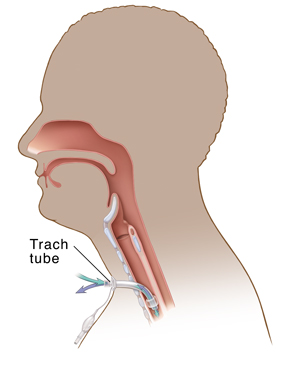If you have a tracheostomy tube
Your tracheostomy (trach) tube has been chosen to fit well and work right for you. You’ll learn how to keep it clean and clear. Often, a trach tube is needed for only a short time. Your surgeon will tell you how long to use the tube. If you don’t need a new airway after surgery, the hole in the front of your throat will close on its own after the trach tube has been removed. You will have a dressing over the site while it heals. In some cases, surgery is needed to close the hole.
If you have a stoma
If your larynx was removed during surgery, you’ll continue to breathe through the hole in your throat. This hole is called a stoma or permanent tracheostomy. It's important that you and those who care for you know that this is your only airway. In a medical emergency, healthcare providers won't be able to put in a breathing tube through your nose or mouth. You’ll be shown how to care for your stoma. Support groups can help you adjust to having a new airway. And you can return to work, family life, and many of the activities you enjoyed before surgery.
You will need follow-up visits for your tracheostomy and its care.
When to call your healthcare provider
Call your healthcare provider right away if you have any of these problems:
-
A red or painful stoma
-
Small amount of bleeding, that stops promptly, from the tube or stoma
-
Yellow, smelly, bloody, or thick mucus around or inside your stoma
-
Pain while cleaning your airway
-
Persistent cough
Call 911
Call 911 if any of the following occur:
-
Trouble breathing or wheezing
-
Coughing up blood
-
Large amount of bleeding, or persistent bleeding, from the tracheostomy site
-
Swelling around the trach tube or stoma


